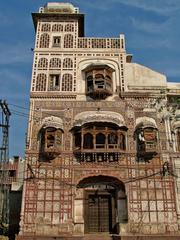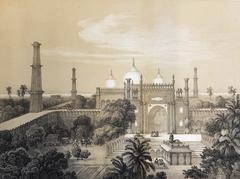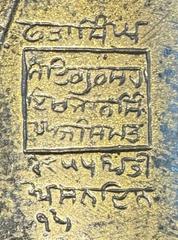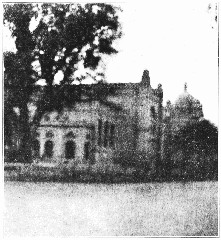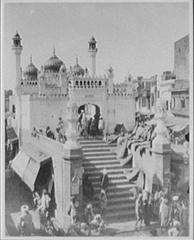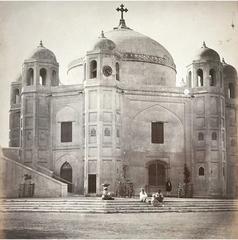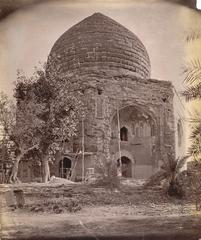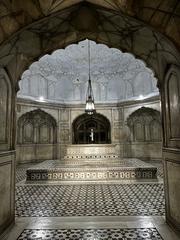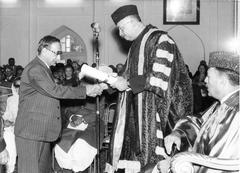Lohari Gate Lahore: Visiting Hours, Tickets, and Historical Guide
Date: 14/06/2025
Introduction
Lohari Gate is one of the most prominent of the thirteen historic entrances to Lahore’s Walled City, standing as a living testament to the city’s Mughal, Sikh, and British colonial past. Originally constructed during the reign of Mughal Emperor Akbar in the late 16th century, it has played a pivotal role in Lahore’s commercial, cultural, and urban development. Today, Lohari Gate continues to be a vibrant hub, seamlessly integrating centuries-old traditions with the dynamic rhythms of modern city life. This detailed guide outlines everything visitors need to know—from history and architecture to practical travel information, accessibility, and nearby attractions—ensuring a memorable and insightful experience at this iconic Lahore landmark (Walled City of Lahore Authority; Dawn News).
Table of Contents
- Historical Overview
- Architectural Features and Restoration
- Socio-Cultural and Economic Importance
- Visitor Information (Hours, Tickets, Accessibility)
- Travel Tips
- Nearby Attractions
- Frequently Asked Questions (FAQ)
- Visuals and Media Suggestions
- Summary and Conclusion
- Sources
Historical Overview
Origins and Early Development
Lohari Gate derives its name from the Urdu word “Lohar,” meaning blacksmith, alluding to the area’s historical association with blacksmiths and metalworkers. Its construction during Akbar’s reign marked the southern gateway into Lahore, welcoming traders and travelers from Multan and beyond (Walled City of Lahore Authority). Over time, the strategic placement of the gate fostered the growth of Lohari Mandi, the subcontinent’s oldest market, and established the area as a vital commercial and social nucleus (Heritage Chronicles Lahore).
Mughal, Sikh, and British Periods
The Mughal era saw the gate serve as both a defensive bastion and a symbol of Lahore’s prosperity. Robust architecture, including thick wooden doors and iron spikes, reflected its strategic importance (Pakistan Today). With the Sikh Empire’s ascendancy, modifications were introduced to enhance defenses. British colonial rule later diminished the city’s fortifications, but Lohari Gate survived, albeit with architectural adaptations blending Mughal, Sikh, and colonial styles (The Friday Times; Heritage Foundation Pakistan).
Architectural Features and Restoration
Lohari Gate’s design fuses Mughal, Sikh, and British influences, characterized by:
- Brick masonry and lime mortar construction
- Arched central entrance flanked by semi-octagonal bastions
- Decorative motifs, floral patterns, and calligraphic inscriptions
- Jharokas (balconies) with intricate cut-brick ornamentation
- Mirror-work inspired by Lahore Fort’s Sheesh Mahal
The upper floors, once occupied by officials and guards, now host Walled City Lahore Authority offices. Restoration efforts led by the WCLA have revitalized the gate, including structural repairs, cleaning, and the revival of traditional decorative elements (UNESCO Lahore; Business Recorder). The project has reclaimed the gate’s historical appearance while improving safety and accessibility for visitors.
Socio-Cultural and Economic Importance
Living Heritage and Community Hub
Lohari Gate is not just a monument; it is the vibrant heart of a living neighborhood. Historic mosques (e.g., Masjid Chiniyan Wali), shrines, and havelis surround the gate, fostering a unique blend of religious, artistic, and communal life (Dawn News). Annual processions, festivals like Basant, and community gatherings animate the area, sustaining traditions and shared identity (World City History).
Economic Role
Lohari Mandi, within the gate, remains a bustling commercial center—renowned historically for indigo, textiles, spices, and crafts (Graana). Restoration projects have boosted heritage tourism, supporting local businesses and artisans, and contributing to sustainable urban development (Business Recorder).
Visitor Information
Visiting Hours
- Lohari Gate: Open to visitors daily, generally from 8:00 AM to 8:00 PM. Some sources note 9:00 AM to 7:00 PM, but as a public thoroughfare, the gate itself is accessible at all times.
- Lohari Mandi Market: Most active from 10:00 AM to 8:00 PM.
Tickets and Entry Fees
- Entry: Free for all visitors.
- Guided Tours: Available through the Walled City Lahore Authority. Fees may apply for guided access to upper floors or special events.
Accessibility
- The area is best explored on foot due to narrow, historic lanes.
- Accessibility for wheelchairs and strollers is limited; consult local guides or WCLA for assistance.
- Rickshaws and taxis can drop visitors near the gate; parking is best arranged outside the Walled City.
Travel Tips
- Wear comfortable shoes for walking on uneven, cobbled streets.
- Visit early morning or late afternoon for pleasant weather and fewer crowds.
- Carry cash (small denominations) as most vendors do not accept cards.
- Dress modestly, especially when visiting religious sites. Carry a scarf for mosque visits.
- Use digital maps or join guided tours for a richer historical experience.
- Be mindful of security in crowded markets—keep valuables safe.
Nearby Attractions
- Wazir Khan Mosque: Celebrated for its Mughal architecture and tilework (19 min walk).
- Anarkali Bazaar: Historic shopping district (20 min walk).
- Data Darbar: Revered Sufi shrine (12 min walk).
- Lal Haveli: Exquisite Sikh/British-era mansion with mirror-work jharokas.
- Lahore Museum, Sunehri Mosque, Begum Shahi Mosque: All within a 15–20 min walk.
Frequently Asked Questions (FAQ)
Q: What are Lohari Gate’s visiting hours?
A: The gate is accessible 24/7 as a public thoroughfare; markets and guided tours generally operate from 8:00/9:00 AM to 7:00/8:00 PM.
Q: Is there an entry fee?
A: No, visiting Lohari Gate is free. Guided tours may require a fee.
Q: How do I reach Lohari Gate?
A: Via public transport, rickshaw, taxi, or ride-hailing services. Limited parking is available; walking is recommended within the Walled City.
Q: Is Lohari Gate accessible for people with disabilities?
A: Accessibility is limited due to narrow and uneven streets; advance arrangements are advisable.
Q: What is the best time to visit?
A: October to March (cooler months). Early morning and late afternoon for comfortable temperatures and optimal lighting.
Visuals and Media Suggestions
- Images: High-resolution photos of Lohari Gate’s façade, market scenes, and architectural details.
- Alt Texts: “Lohari Gate Lahore - Historic Entrance,” “Lohari Mandi Market near Lohari Gate,” “Jharokas with mirror work at Lohari Gate.”
- Maps: Interactive maps highlighting Lohari Gate and nearby attractions.
- Virtual Tours: Consider digital or video tours for remote visitors.
Summary and Conclusion
Lohari Gate stands as a dynamic symbol of Lahore’s evolving history, enduring architecture, and vibrant community life. Its restoration and continued use as a commercial and cultural hub bridge the past with the present, offering visitors a unique window into the city’s soul. Whether you are a history enthusiast, a shopper, or a cultural explorer, Lohari Gate promises an immersive and memorable experience. Enhance your visit by exploring nearby landmarks, engaging with local artisans, and utilizing digital resources like the Audiala app for guided tours and up-to-date information.
Sources
- Walled City of Lahore Authority
- Dawn News
- The Friday Times
- Heritage Foundation Pakistan
- Heritage Chronicles Lahore
- Away With The Steiners
- Business Recorder
- World City History
- Trek Zone
- UNESCO Lahore
- Graana
- Laure Wanders
